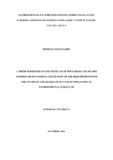ENVIRONMENTAL FACTORS INFLUENCING WOMEN SMALL SCALE FARMERS’ ADOPTION OF CONSERVATION AGRICULTURE IN NAKURU COUNTY, KENYA
Abstract
This research examines four environmental factors influencing women farmers’ adoption of conservation agriculture (CA) in Nakuru County, Kenya. About 30% of environmental problems in the world, and particularly in the study area emanate from poor agricultural practices. CA is currently being promoted as a better practice than the conventional farming methods because CA has been found to result in optimum agricultural production. In addition to resulting in better agricultural yields, CA protects the environment. The level of environmental degradation in the study area is high, resulting in food insecurity and biodiversity loss. Women small scale farmers’ participation in agriculture is 70% of all the farming activities in the area and therefore, women are most affected by environmental changes. Food insecurity and biodiversity loss can be solved through adoption of CA practices which are rare in the study area, especially among women small scale farmers. The farmers have claimed that, CA adoption is not prevalent due to some environmental factors. This claim was inadequately substantiated. The research sampled three sites: Naivasha, Rongai and Njoro which were selected purposefully due to different ecological characteristics. Three hundred and ninety women farmers were randomly selected from a target population of 120, 000 women farmers of which, 130 were selected from each of three Sub Counties. The study uses the descriptive survey research design. Structured questionnaires, interview schedule, personal observation and focus group discussion were used to collect data, which included secondary information. Statistical Package for Social Sciences (SPSS version 20) computer system was used in the data processing and analysis. Descriptive statistics; frequency distributions, means, proportions, percentages and inferential statistics; Chi-square, ANOVA, and post hoc analysis at alpha value = 0.05 level were employed to test four hypotheses. The findings rejected the four null hypotheses of the specific objectives and concluded that extension methods, climate change, land use changes and knowledge of environment significantly influenced women farmers’ adoption of CA. The study concludes that CA adoption uptake is low, government policy on extension methods is not well structured, self-help women groups are significantly effective, ICT and video sharing are more effective methods of passing information on best farming practices, but they are rarely used. The following are the recommendations: the use of schools, markets, religious centers for training and the establishing of weather stations in schools. It is hoped that policy and decision makers will use the results of the study to develop land and agricultural policies, provide incentives to promote women small-scale farmers, use new emerging technologies such as ICT, videos and smart phones as well as restructure involvement of self-help women groups to speed up adoption of CA in order to realize food security and conservation of the environment in Nakuru County and in Kenya.

